
views
US President Joe Biden hosted the Asia-Pacific Economic Cooperation (APEC), the annual summit of Asian leaders in San Francisco where leaders from 21 Asia-Pacific countries participated. During the summit, Biden and his Chinese counterpart Xi Jinping made rival bids to win over Asia-Pacific allies at the nations met in a bid to reduce tensions between the superpowers.
This was the second in-person dialogue of Biden with Xi since the US president assumed office in 2021. Biden also had a three-way meeting with Japanese Prime Minister Fumio Kishida and South Korean President Yoon Suk Yeol, whom he hosted for a historic summit at Camp David in August.
The conference comes in the backdrop of the frosty relationship between China and the US and global turmoil from the Israel-Hamas war and Ukraine War.
WHAT IS APEC?
APEC or Asia-Pacific Economic Cooperation is a forum to promote trade, investment and economic development among nations around the Pacific Ocean. The group started with 12 members in 1989, but has since grown to 21.
The current members are Australia, Brunei, Hong Kong, New Zealand, Papua New Guinea, the Philippines, Indonesia, China, Japan, South Korea, Russia, Canada, the United States, Mexico, Peru, Chile, Malaysia, Vietnam, Singapore, Thailand and Taiwan. The member nations account for nearly 40% of the global population and almost half the world’s trade.
The annual leaders’ conference brings together heads of nations and other top economic and diplomatic leaders. White House aides say the goal for this year’s summit is to try to make APEC economies more resilient, particularly in the face of growing climate issues and following a global pandemic that killed millions of people and strained supply chains.
The leaders who are attending the summit include Japan’s PM Fumio Kishida, Canada’s PM Justin Trudeau, and Indonesia’s President Joko Widodo.
US, China Competing for influence
China and the United States are competing for influence across the hugely dynamic area stretching from the coasts of Canada to Chile and across to Australia, Malaysia and Russia. Biden’s goal for Xi meeting is to get US-China communications back to normal.
In the meeting on the sidelines of the summit, Biden and Xi are stressing the need for their nations to strengthen mutual understanding while cautioning that their interests will sometimes conflict. The two leaders opened their face-to-face meeting in the San Francisco Bay area with a solid handshake. Later, they sat at one long table together rather than at separate ones.
While China has been offering infrastructure and loans with its “Belt and Road” program, the United States is busily trying to strengthen alliances with trade and other agreements.
A big plank in that platform is the Indo-Pacific Economic Framework for Prosperity (IPEF) — a loose trade pact meant to bind together the United States and 13 like-minded democracies such as Australia and South Korea. However, the IPEF has already hit the buffers because of US domestic political opposition that has held up a key element.
Why is India not a part of APEC?
In 1991, India made a request to become a part of the grouping when the economy was liberalised. Though a majority of the members were in favour of India’s inclusion, but some countries had reservations about India’s “protectionist instincts” and cited its records on the economic reforms, as per reports.
Another reason for India not being included in the grouping was a membership freeze, which was in force since 1997 but was not extended in 2012.
According to a report in Firstpost, the US-India Joint Strategic Vision for the Asia-Pacific and Indian Ocean Region issued in 2015 said, “The United States welcomes India’s interest in joining the Asia Pacific Economic Cooperation forum, as the Indian economy is a dynamic part of the Asian economy.”
India, however, remains an observer of APEC and has been expanding trade and investment ties in the region since the 2000s. India has been an observer of the group since 2011.
Union Minister for Commerce and Industry Piyush Goyal is attending the APEC summit even though New Delhi is not a member of the bloc. Goyal met Joe Biden at the APEC welcome reception on Thursday.
Extremely pleased to join @POTUS & other leaders of the Indo-Pacific Economic Framework for Prosperity (IPEF) for the IPEF Leaders meeting & to collectively announce that IPEF Leaders’ Vision has found a concrete shape with Agreements on Pillars II, III & IV. I am confident… pic.twitter.com/dJodS2uePk
— Piyush Goyal (@PiyushGoyal) November 17, 2023
Goyal told ANI that Joe Biden conveyed his greetings to Prime Minister Narendra Modi and acknowledged that the countries which were not responsible for creating the environmental degradation in the first place are the countries which get impacted the most.
HOW EFFECTIVE IS APEC?
Ever since its formation, the APEC group has championed the lowering of trade tariffs, free trade, and economic liberalisation. There is no military component and it wasn’t forged by a world-altering event like a war.
It technically has member “economies” rather than countries. That allows room for participation by both China-ruled Hong Kong and self-ruled Taiwan.
APEC’s strength lies in its ability to get countries to work together on big initiatives and to ease business relations without binding agreements. Economists point to how APEC contributed to a reduction of tariffs and other barriers to trade.
But the trade landscape is different now than when APEC began in a period of increased globalization. The US strategy has been focused on economic competition with China rather than cooperation, even as US leaders continue to stress the importance of cooperation. Biden is seeking partnerships with other nations in the region to develop alternatives to Chinese manufacturing imports such as electronic equipment, machinery, furniture, textiles and other goods.
(With inputs from agencies)
















Comments
0 comment